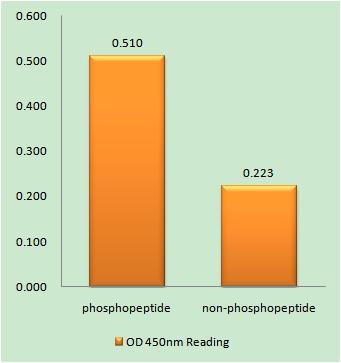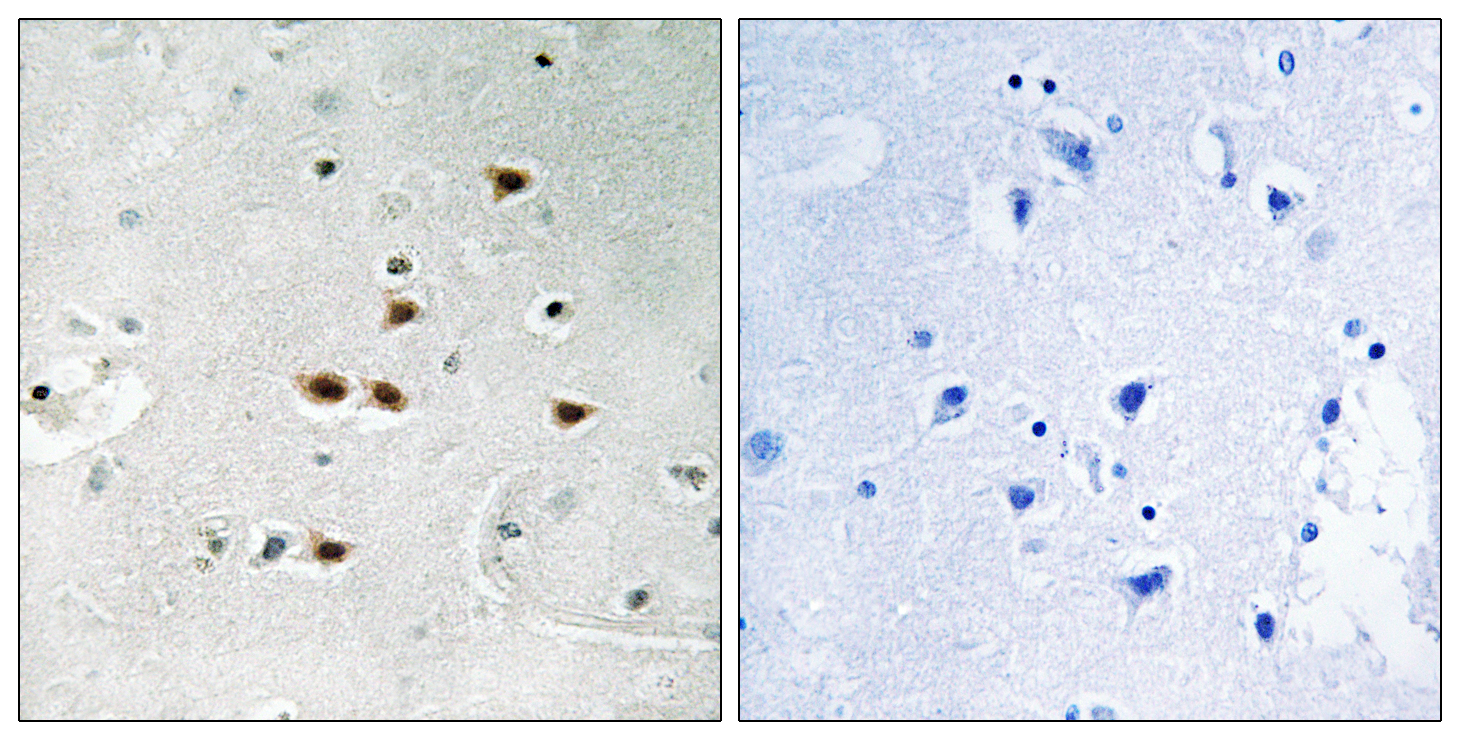AIP4 (phospho Tyr420) Polyclonal Antibody
- Catalog No.:YP1072
- Applications:IHC;IF;ELISA
- Reactivity:Human;Mouse
- Target:
- AIP4
- Fields:
- >>Ubiquitin mediated proteolysis;>>Endocytosis;>>TNF signaling pathway;>>Non-alcoholic fatty liver disease
- Gene Name:
- ITCH
- Protein Name:
- E3 ubiquitin-protein ligase Itchy homolog
- Human Gene Id:
- 83737
- Human Swiss Prot No:
- Q96J02
- Mouse Gene Id:
- 16396
- Mouse Swiss Prot No:
- Q8C863
- Immunogen:
- The antiserum was produced against synthesized peptide derived from human ITCH around the phosphorylation site of Tyr420. AA range:386-435
- Specificity:
- Phospho-AIP4 (Y420) Polyclonal Antibody detects endogenous levels of AIP4 protein only when phosphorylated at Y420.
- Formulation:
- Liquid in PBS containing 50% glycerol, 0.5% BSA and 0.02% sodium azide.
- Source:
- Polyclonal, Rabbit,IgG
- Dilution:
- IHC 1:100 - 1:300. ELISA: 1:20000.. IF 1:50-200
- Purification:
- The antibody was affinity-purified from rabbit antiserum by affinity-chromatography using epitope-specific immunogen.
- Concentration:
- 1 mg/ml
- Storage Stability:
- -15°C to -25°C/1 year(Do not lower than -25°C)
- Other Name:
- ITCH;E3 ubiquitin-protein ligase Itchy homolog;Itch;Atrophin-1-interacting protein 4;AIP4;NFE2-associated polypeptide 1;NAPP1
- Molecular Weight(Da):
- 103kD
- Background:
- itchy E3 ubiquitin protein ligase(ITCH) Homo sapiens This gene encodes a member of the Nedd4 family of HECT domain E3 ubiquitin ligases. HECT domain E3 ubiquitin ligases transfer ubiquitin from E2 ubiquitin-conjugating enzymes to protein substrates, thus targeting specific proteins for lysosomal degradation. The encoded protein plays a role in multiple cellular processes including erythroid and lymphoid cell differentiation and the regulation of immune responses. Mutations in this gene are a cause of syndromic multisystem autoimmune disease. Alternatively spliced transcript variants encoding multiple isoforms have been observed for this gene. [provided by RefSeq, Mar 2012],
- Function:
- function:E3 ubiquitin-protein ligase which accepts ubiquitin from an E2 ubiquitin-conjugating enzyme in the form of a thioester and then directly transfers the ubiquitin to targeted substrates. Regulates the transcriptional activity of several transcription factors, and probably plays an important role in the regulation of immune response.,pathway:Protein modification; protein ubiquitination.,PTM:Phosphorylated on tyrosine residues.,similarity:Contains 1 C2 domain.,similarity:Contains 1 HECT (E6AP-type E3 ubiquitin-protein ligase) domain.,similarity:Contains 4 WW domains.,subunit:Interacts via its WW domains with DRPLA, NFE2 and CBLC. Interacts with Epstein-Barr virus LMP2A. Interacts with NOTCH1, OCLN, JUN and JUNB. Interacts with NDFIP1 in vitro (By similarity). Interacts with ARHGEF7.,tissue specificity:Widely expressed.,
- Subcellular Location:
- Cell membrane ; Peripheral membrane protein ; Cytoplasmic side . Cytoplasm . Nucleus . Early endosome membrane ; Peripheral membrane protein ; Cytoplasmic side . Endosome membrane ; Peripheral membrane protein ; Cytoplasmic side . May be recruited to exosomes by NDFIP1 (PubMed:18819914). Localizes to plasma membrane upon CXCL12 stimulation where it co-localizes with CXCL4 (PubMed:14602072). Localization to early endosomes is increased upon CXCL12 stimulation where it co-localizes with DTX3L and CXCL4 (PubMed:24790097). .
- Expression:
- Widely expressed.
- June 19-2018
- WESTERN IMMUNOBLOTTING PROTOCOL
- June 19-2018
- IMMUNOHISTOCHEMISTRY-PARAFFIN PROTOCOL
- June 19-2018
- IMMUNOFLUORESCENCE PROTOCOL
- September 08-2020
- FLOW-CYTOMEYRT-PROTOCOL
- May 20-2022
- Cell-Based ELISA│解您多样本WB检测之困扰
- July 13-2018
- CELL-BASED-ELISA-PROTOCOL-FOR-ACETYL-PROTEIN
- July 13-2018
- CELL-BASED-ELISA-PROTOCOL-FOR-PHOSPHO-PROTEIN
- July 13-2018
- Antibody-FAQs
- Products Images

- Enzyme-Linked Immunosorbent Assay (Phospho-ELISA) for Immunogen Phosphopeptide (Phospho-left) and Non-Phosphopeptide (Phospho-right), using ITCH (Phospho-Tyr420) Antibody

- Immunohistochemistry analysis of paraffin-embedded human brain, using ITCH (Phospho-Tyr420) Antibody. The picture on the right is blocked with the phospho peptide.



